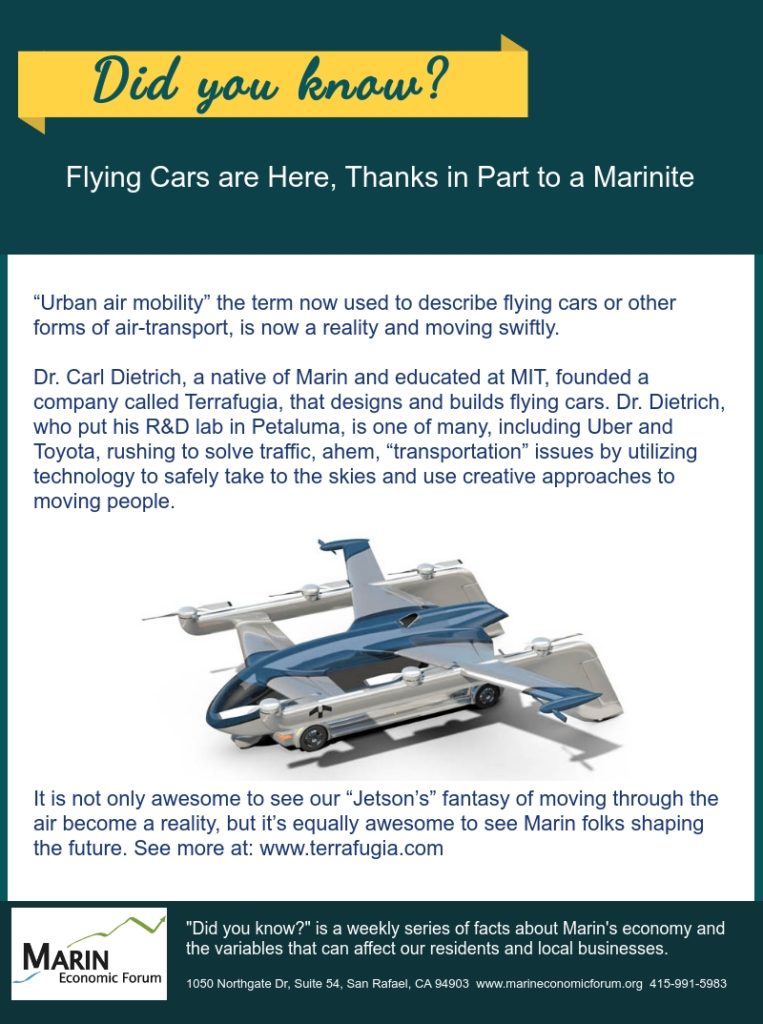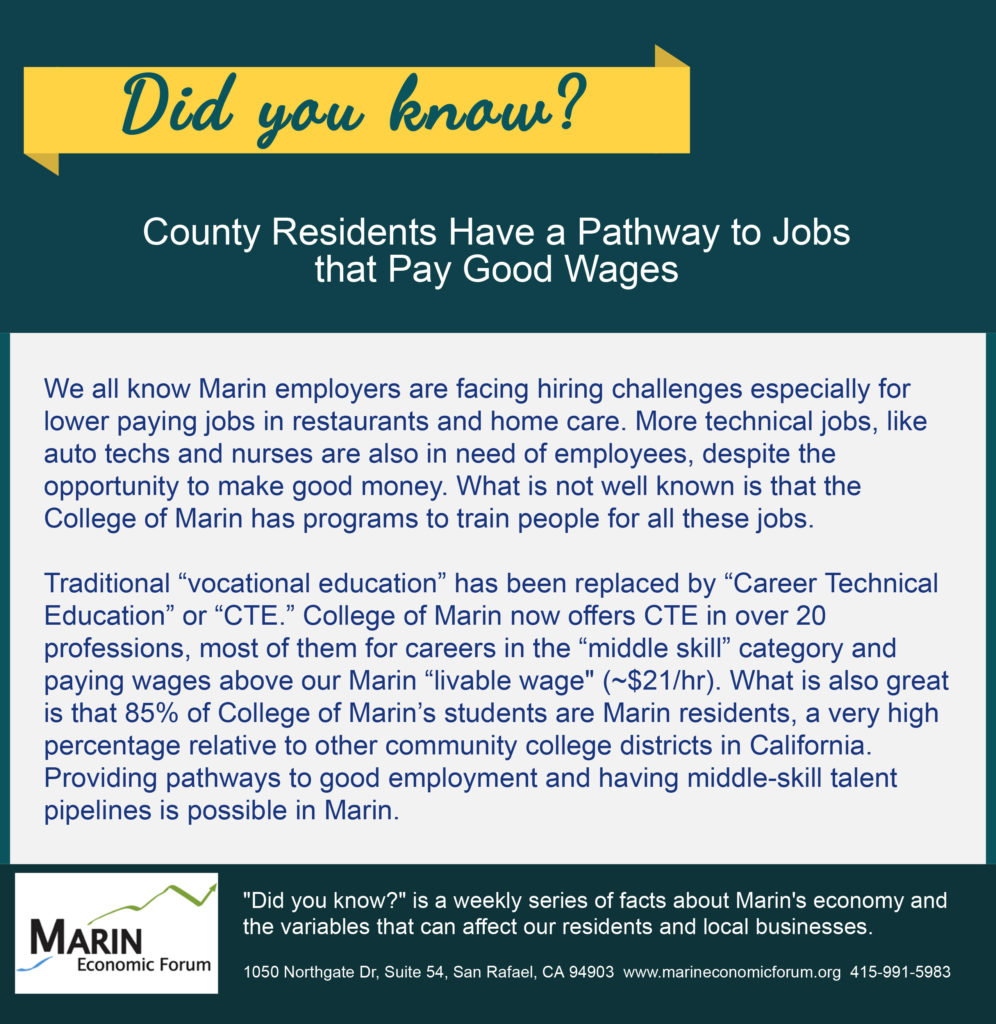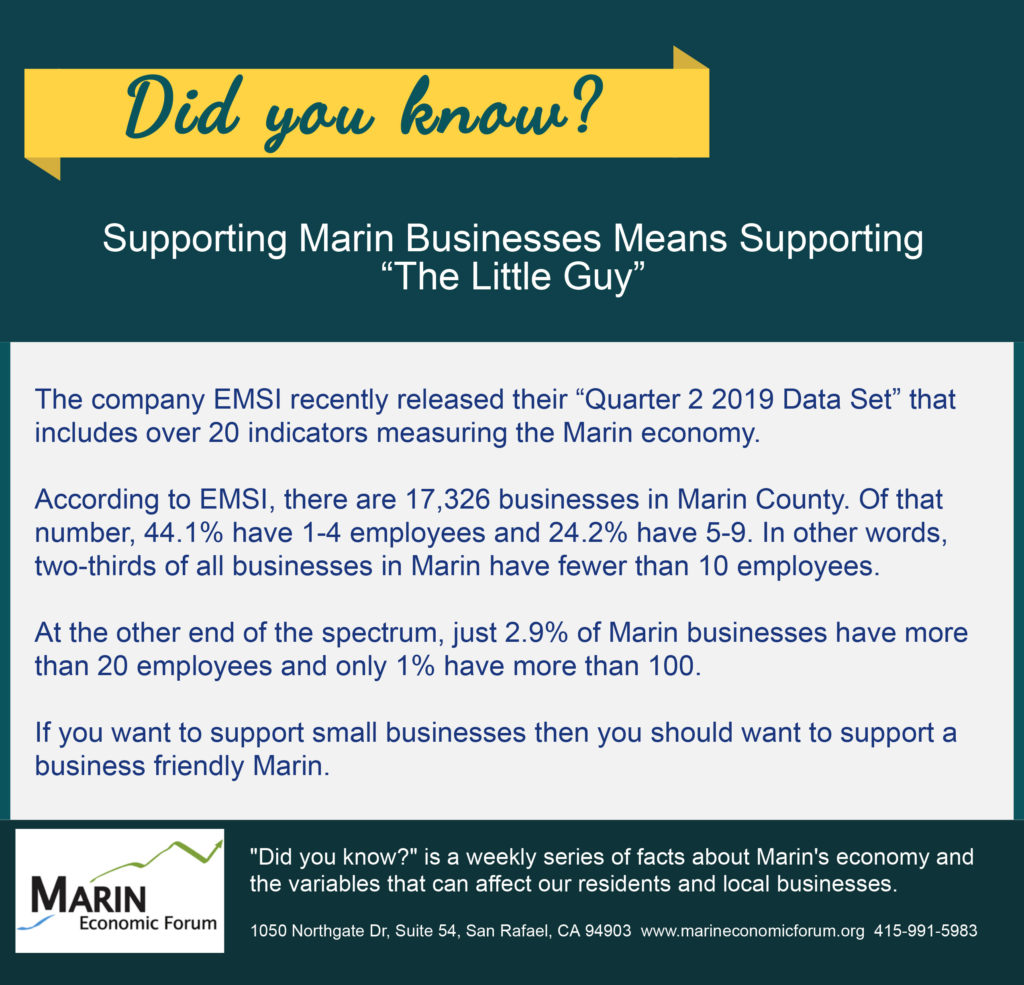June 20, 2019 Did You Know?







July 3, 2019
In May of this year Marin County’s unemployment rate dipped below 2% (1.9%) for the first time in 20 years (also 1.9% in May 1999). If you are an elected official or policymaker the low figure should please you, signaling that almost all your citizens that want a job have a job. Business owners are on the opposite end, fretting over a tight labor market that could mean a raise in wages, prices and potentially lower profits. There is a third category of people that are impacted: residents that rely on local goods and services. Have you noticed an increase in the cost of things lately or has the service at your favorite eatery slumped because they don’t have enough staff?

The Marin Economic Forum has been conducting a “business retention and expansion” (“BRE”) project in Marin County to measure the health of our local businesses. We have already talked with over 40 businesses and without a doubt the #1 issue for all of them is staffing. This is not news for most of you but here is what is newsworthy: the labor shortage bears all the characteristics of another issue we refer to as a “crisis,” housing. Labor, like housing, is a supply and demand issue. Labor, like housing, is tight because there is not enough supply of workers. But here is why I also consider the labor shortage a crisis: Unlike housing, our labor supply is diminishing.
Marin County imports a huge percentage of its workforce (63%) and our population demographics show less than 10% of our residents are aged 18-34. Meanwhile the proportion of older adults, those who will leave the workforce, is growing at an increasing rate. We only have one university and one community college here that graduates an average of 1000 students a year; that is less than 1% of our labor force even if all those graduates got jobs in Marin.
Of concern is that we know the current labor shortage is due in part to lack of housing so one crisis is exacerbating another. Worse, unlike housing, where at least a half-dozen, well-informed advocacy groups are trying to address the issue, there are no leading advocates to address our “labor crisis.” To be fair, the construction industry has acted with new training programs and the Marin County Office of Education is working at the high school level to expedite students into careers should they choose that path. But residents should be aware that we are approaching structural issues with our labor force, including lack of talent and programs to secure a labor pipeline.
Compare Marin with other regions around the country also facing labor and housing shortages and you see more aggressive action: the hospitality sector in Seattle is investing serious money in “upskilling” employees so employers can do more with less, Colorado Springs is filling jobs in manufacturing, IT and child development by providing accelerated training to underemployed and undereducated people in the community, and in Wisconsin, where the population has been stagnant and getting older, the State has invested over $1 million in a marketing campaign to attract millennials from urban centers like Chicago, selling a high quality of outdoor life. These regions were driven to address their labor shortages and did so. What are we doing in Marin? Not enough
Mike Blakeley, CEO
Marin Economic Forum

On Friday June 21, 2019 State Senator Mike McGuire (D-District 2) addressed the MEF Board of Directors meeting held at BioMarin, San Rafael, to provide an update on several key issues for the California and Marin economy. California’s significant role in the world economy (ranked 5th) is well known but most residents may not understand how that relates to funding for public goods and services.
May 16, 2019
In the field of economics there are a lot of funny terms. Remember just a short while ago we were all talking about “quantitative easing?” There is another funny term, “Location Quotient” or “LQ” that I think Marin residents should know about.
LQ is basically a way to compare a region’s economy to the nation by measuring the concentration of things like occupations, industry presence or even demographics. LQ is measured with a number (a ratio actually) against the benchmark of “1” for the national average. An LQ measurement above 1 suggests a higher concentration of something, say architects, compared to other regions. The assumption is that an LQ measure greater than 1 means that occupation, or industry has a relatively more significant role in a region. Take the city of Detroit; the automobile manufacturing industry has a LQ over 10 (!) demonstrating its huge importance to that city’s economy and its residents relative to other places in the U.S.
The table below shows the LQ for ‘occupations’ in Marin. This means that for the sectors presented, there is either a high concentration or low concentration of those jobs in Marin compared to other regions. I chose “occupations” because it is important to understand the jobs we have here in Marin compared to the nation.

Here are some of the interesting stories about the LQ measurements above and some related data:
Overall, we can observe 11 sectors that have LQ’s greater than 1 but only 6 of them pay higher than a “livable wage” by Marin standards. So as far as occupation LQ’s telling a story about the uniqueness of the Marin economy, one might say we have a higher concentration of lower paying jobs and that occupations in two of the best paying sectors have a lower relative concentration in Marin than the national average. That should be perceived as a problem; the occupations we have aren’t necessarily the occupations we need given the high cost of living and our assets, which includes a highly educated population. Strictly going by occupation LQ, Marin has work to do.
Mike Blakeley, CEO
Marin Economic Forum
Marin Independent Journal
High demand, tight labor and tariffs lead to record prices
The Bay Area is the most expensive place in the world to build an apartment building, office tower, hospital, warehouse or school.
And it’s not even close — the region is 13 percent more costly to develop than second-place New York, according to a new report by UK-based consultant Turner & Townsend.
“Another dubious award for the Bay Area,” said Russell Hancock, CEO of the non-partisan, regional think-tank Joint Venture Silicon Valley.
The report blamed high costs on a combustible mixture of high demand, labor shortages, steel tariffs and rapid economic growth.
Even as the expanding Bay Area economy demands more homes, offices, roads and transit projects, rising costs could threaten development, forcing project delays or changes in size and scope.